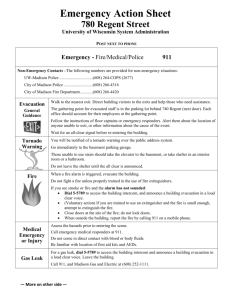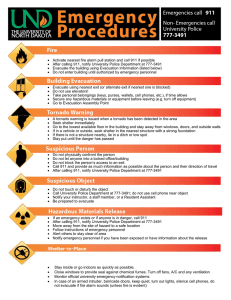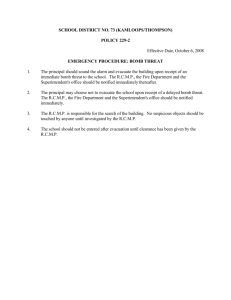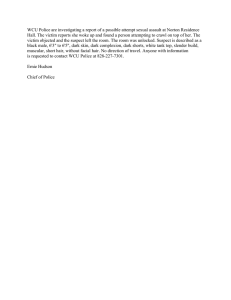Emergency Handbook - Eastern Illinois University
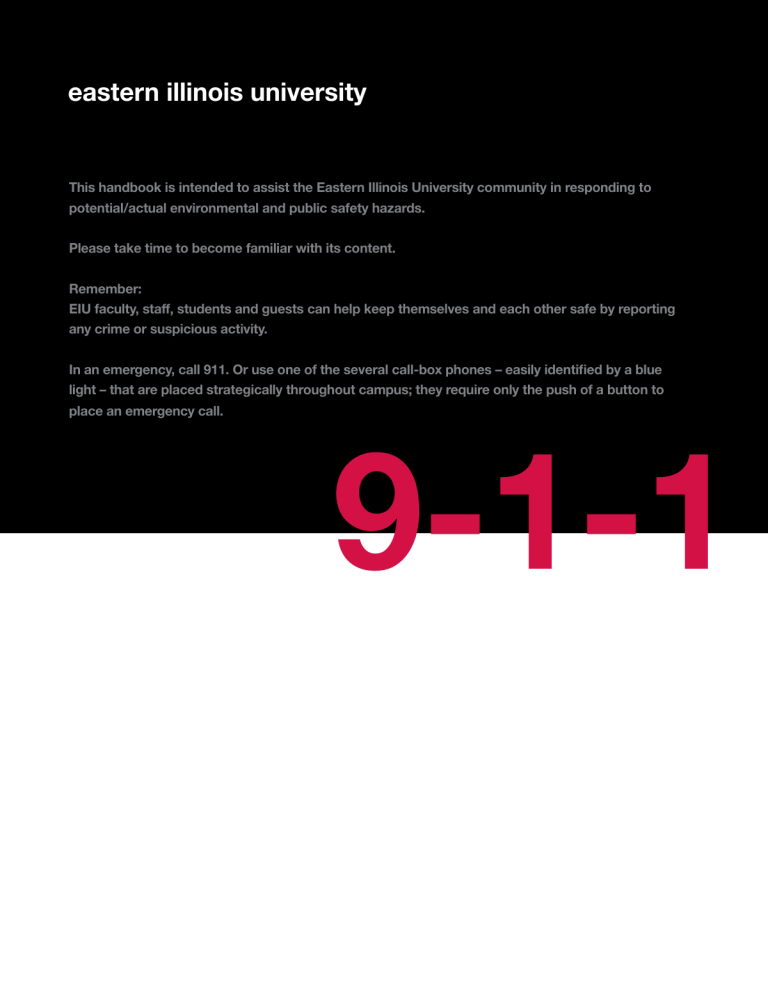
eastern illinois university
This handbook is intended to assist the Eastern Illinois University community in responding to potential/actual environmental and public safety hazards.
Please take time to become familiar with its content.
Remember:
EIU faculty, staff, students and guests can help keep themselves and each other safe by reporting any crime or suspicious activity.
In an emergency, call 911. Or use one of the several call-box phones – easily identified by a blue light – that are placed strategically throughout campus; they require only the push of a button to place an emergency call.
9-1-1
active shooter
Please note that these types of incidents are highly unpredictable. An individual’s response should depend on the particular circumstances at hand.
Secure Immediate Area: i Clear hallways immediately.
i Do not attempt to confront or apprehend shooter
(unless as a last resort).
i Lock and barricade doors if unable to exit the building safely.
i Turn off lights.
i Close blinds and block windows.
i Turn off radios and computer monitors.
i Keep occupants calm, quiet and out of sight. Take adequate cover/protection from bullets (i.e., concrete walls, thick desks, filing cabinets).
i Silence cell phones.
i Do not leave the room or unlock the door to see “what is happening.” i Place signs in exterior windows to identify the location of injured persons.
Contact Authorities: i Call 911 as soon as safely possible. Do not put yourself or anyone else in danger.
What to Report: i Your specific location, including building name and office/room number.
i Number of people at your specific location, and numbers/types of injuries.
i Number and location of assailant(s), plus descriptors: race and gender; clothing description; physical features; weapon types (long gun or handgun); backpack; shooter’s identity, if known; separate gunfire; explosions; etc.
Un-Securing an Area: i Remember: A shooter may not stop until he is engaged by an outside force.
i Consider risks before un-securing rooms. If doubt exists for the safety of the individuals inside a room, that area should remain secured.
i Consider the safety of the masses vs. the safety of the few. Attempts to rescue people should only be made if they can be accomplished without further endangering
active shooter
bomb threat
If you receive a bomb threat by telephone, remain calm. Do not interrupt the caller.
Be perceptive. Listen for and try to determine: i Age of caller i Gender of caller i Race of caller i Any unusual voice characteristics i Background noises
Do not rely on memory. Write down information, including time of call.
i Where is the bomb located?
i When is the bomb going to explode?
i What does it look like?
i What kind of bomb is it?
i What will cause it to explode?
i Who placed the bomb? The caller?
i Name and address of caller?
Upon receipt of a bomb threat (by phone or in writing): i Quickly examine your area for any unusual or unfamiliar items or packages. Do NOT disturb the item. Report findings to University Police.
i Do not use radios, pagers or cell phones as they can trigger an explosive device.
i Do not evacuate by pulling a fire alarm.
i Do not turn lights (or other electrical fixtures/ equipment) on or off.
Evacuation Notification i If emergency responders (police, firefighters, etc.) order an evacuation, clear all people from the area immediately. Be sure and take the written threat and/or notes about the call with you.
Report all bomb threats – written or oral – to
University Police ( 911 ).
bomb threat
building evacuation
You MUST evacuate when ordered to do so.
This includes both the activation of an audible/visible fire alarm and/or verbal orders from police or emergency response personnel.
In case of an evacuation: i Remain calm; walk, do not run. Keep noise to a minimum.
i Move in an orderly manner to the nearest exit. Exit signs are located throughout buildings, and evacuation routes are posted near public entrances and within each classroom.
i If smoke is in the air, stay as close to the floor as possible. Crawl, if necessary.
i Cover your nose and mouth with a wet cloth/paper towel, if possible.
i With back of hand, feel any closed doors for heat.
• If not hot, brace yourself against the door and open it slowly.
• If hot, DO NOT OPEN . Seek an alternate escape route.
i Use the stairs. Do NOT use elevators.
• Do not push or crowd. Hold on to handrails in stairwells.
• Assist people with disabilities, when possible.
i If relocating outside building (safe area),
• Move to an assembly area at least 300 feet from the building and watch for falling debris.
• Keep streets clear for emergency vehicles.
If you are unable to leave the building because of a physical disability, injury or obstruction: i Go to the nearest safe area.
i Notify University Police at 911 .
i Signal out a window, if possible.
i Remain calm. Responders will arrive.
Do not re-enter the building until authorized by police or other emergency response personnel.
building evacuation
earthquake
If indoors: i Stay inside.
i Take cover under a piece of heavy furniture or against an inside wall and hold on.
i The most dangerous thing to do during an earthquake is to try to leave the building. Objects can fall on you.
If outdoors: i Move into the open, away from buildings, streetlights and utility wires.
i Once in the open, stay there until the shaking stops.
If in a moving vehicle: i Move to a clear area away from buildings, trees, overpasses or utility wires.
i Stop quickly and stay in the vehicle.
i Once the shaking has stopped, proceed with caution.
i Avoid bridges or ramps that might have been damaged by the quake.
After an earthquake, remain cautious. Aftershocks are not uncommon.
earthquake
fire / explosion
Planning ahead is key. Please review the Emergency Response Contingency Plan on file in each department’s office.
Locate – in advance – the nearest fire exit to your office or classroom.
If you discover a fire: i Pull the fire alarm to summon help and alert others in the building. i Evacuate the building using the nearest exit. Close doors behind you. (Fire requires oxygen to burn, and closing doors will help control the fire.) i Do not use elevators.
i If need be, crawl under the smoke. Smoke rises; the cleanest air will be near the ground.
i After leaving the building, reassemble at the appropriate assembly point outside the building. Accountability for students, staff, faculty and guests is critical; report any missing person immediately to authorities.
i Notify authorities by calling 911 . Call from a safe location.
If something (i.e., smoke, heat, flames, debris) blocks your exit routes: i Stay in the room with the door closed.
i If possible, signal for help using a bright-colored cloth at a window.
i If you have access to a telephone, call 911 to alert authorities of your situation.
Stop, Drop and Roll: If your clothes catch on fire, stop where you are, drop to the floor, and roll over and over to smother the flames. Cover your face with hands to prevent inhaling fumes.
If the fire is small and you are trained to do so, extinguish flames using proper extinguisher.
Do not re-enter the building until authorized by police or other emergency response personnel.
fire / explosion
gas leaks / fumes / vapors
If you detect natural gas or toxic/noxious material (fumes or vapors): i Do not pull fire alarms.
i Do not touch light switches or electrical equipment.
i Contact emergency services/University Police by calling 911 .
i Clear the area immediately if instructed to do so by emergency dispatcher.
i Alert others to stay clear of the area.
i Remain upwind of source.
i Provide your location and the location of the odor to dispatcher.
i Provide as many details as possible to dispatcher.
i If evacuation occurs, do not re-enter the building until authorized to do so by emergency personnel.
gas leaks / fumes / vapors
hazardous materials incident
Chemical agents are poisonous gases, liquids or solids that have toxic effects on people, animals or plants.
Biological agents are organisms or toxins that have illness-producing effects on people, livestock and crops.
Both can be extremely dangerous if not handled properly.
The procedures below discuss general safety measures to be taken in case hazardous materials are released into a classroom/office environment. Please note: Individual departments may have specified emergency procedures. Please check with each department for additional information.
DO NOT try to clean up a spill unless you are trained to do so.
If you believe your area is unsafe, evacuate immediately.
i Isolate the area. Secure area, if possible. i Ask exposed individuals to remain nearby until emergency responders arrive. Decontamination may be necessary.
i Account for everyone in the room at an appropriate reassembly point outside the building.
Multiple victims? Their collective presence may indicate continuing danger.
i Approach with caution, and evaluate your surroundings.
i Is the scene/environment safe? If there is any doubt, do not approach. You may become the next victim.
Once safely removed from area of spill, you should report the spill or incident involving hazardous materials by calling 911 .
i Provide location of spill.
i Be prepared to offer details, if known: identification of the spilled/released product, approximate amount of material involved, injuries, any identifiable reaction, identification of those who came in contact with spilled substance, etc. Also, is the material actively being released, or has it slowed/stopped?
hazardous materials incident
hostage situation
If you are taken hostage: i Stay calm. Be cooperative. Avoid eye contact. Don’t threaten or intimidate; appear submissive.
i Remember that lives are your top concern. Before you say or do anything, think of the consequences to yourself and others. Your safety – and theirs – comes first.
i Notify 911 only if it will not put you or anyone else in danger.
i Make careful mental notes about hostage-taker(s): age, skin color, hair and eye color, height and weight, color and type of clothing, distinguishing characteristics (voice, accents, language, etc.) i Follow all directives from law enforcement officials.
hostage situation
medical emergency / injury / illness
In case of an emergency/injury/illness: i Summon help by calling 911 .
Be prepared to provide address, location and incident description, including:
• What is the chief complaint?
• What is the sex and approximate age of the victim?
• How many victims are involved?
• Is the victim conscious?
• Is the victim breathing?
• Does the victim have a pulse?
• Is there severe bleeding?
i Do not move an injured person unless absolutely necessary to prevent additional injury. If the victim must be moved, pull the body lengthwise. When lifting a victim, support each section of the body so “jackknifing” does not occur.
i Make the victim as comfortable as possible until professional help arrives. Reassure him help is on the way.
i Cover the victim with a blanket or coat to keep him warm.
i If there is no breathing or pulse, begin mouth-to-mouth resuscitation or CPR, if trained to do so.
i If vomiting occurs in an unconscious person, turn the victim to one side to prevent choking.
i To stop bleeding, apply pressure and elevate (if bleeding from an extremity). NOTE: Attempt to use or wear some type of personal protective equipment (i.e., rubber gloves, protective barriers, etc.).
i If shortness of breath occurs, elevate the head.
i Clear the room of all non-essential people; send someone to meet the ambulance and direct rescue personnel to your location.
Multiple victims? Their collective presence may indicate continuing danger.
i Approach with caution, and evaluate your surroundings.
i Is the scene/environment safe? If there is any doubt, don’t approach. You may become the next victim.
NOTE: Body fluid (i.e., blood, vomit, etc.) spills should be cleaned up by Eastern’s building service workers, who are trained to handle the cleanup safely. Call Work Control at 581-3416, and please keep yourself and others away from spilled fluid.
After an emergency has been resolved, an accident form should be completed. See the University Process Guide: www.eiu.edu/~environ/Procedures/AccidentForm.pdf
.
medical emergency / injury / illness
person(s) trapped in an elevator
If you become trapped on a university elevator – or know of others who may be trapped – phone University Police at 581-3212.
When reporting the incident: i Give location of the elevator.
i Estimate the number of people trapped.
i Report any injuries.
i Report any noises or occurrences that either preceded the event or that occurred after persons became trapped.
i Continue to talk to people trapped until help arrives.
person(s) trapped in an elevator
psychological crisis / suicide threat
In the event of threatening behavior which appears to represent an immediate threat to self or others, contact University Police at 911 .
When reporting an incident to authorities: i Provide address and location description.
i Provide the phone number at your location.
i Explain the situation to the dispatcher in detail.
i Describe actions taken (i.e., medication, type and amount given) , if any.
Remember: i Take all statements and behaviors seriously.
i It is better to overreact than to not do enough; a person’s life may be at risk.
i Immediately report your concern that a person may be suicidal. Timeliness in reporting the concern is vital.
i Always keep your own safety in mind.
i People who contemplate or attempt suicide are people whose pain has become greater than their resources for coping with the pain.
i Engaging the person in professional help to develop their resources for coping is most appropriate.
Contact the EIU Counseling Center to consult about your concerns: 217-581-3413
(after-hours emergency pager number: 217-348-2909).
psychological crisis / suicide threat
severe thunderstorm / lightning
SEVERE THUNDERSTORM
WATCH
Conditions exist for the development of severe thunderstorms, including damaging winds and/or hail.
SEVERE THUNDERSTORM
WARNING
A severe thunderstorm has been sighted or indicated by radar.
If indoors: i Be prepared to go to an inside hallway at the lowest level.
i Avoid pole buildings or similarly structured buildings.
i Avoid places with wide-span roofs such as auditoriums, cafeterias or large hallways.
i Listen to a battery-operated radio or television for the latest storm information (local television/radio station, National
Weather Service radio, etc.).
i Do not handle any electrical equipment or telephones; lightning could follow the wire. Television sets are particularly dangerous at this time.
i Avoid water faucets and sinks; metal pipes can transmit electricity.
If outdoors: i If possible, get inside a building or car. If shelter is not available or if there is no time to get indoors, lie in a ditch or lowlying area or crouch near a strong building. Be aware of the potential for flooding.
i Avoid tall structures such as towers, tall trees, fences, telephone lines or power lines.
i Stay away from natural lightning rods such as golf clubs, tractors, fishing rods, bicycles or camping equipment.
i Stay away from rivers, lakes or other bodies of water.
i If you are isolated in a level field or prairie and you feel your hair stand on end (an indication that lightning is about to strike), bend forward, putting your hands on your knees. Crouch with hands on knees and feet apart. Remove all metal objects.
Do not lie flat on the ground.
If in a vehicle: i Pull safely onto the shoulder of the road and away from any trees that could fall on the vehicle.
i Stay in the car and turn on the emergency flashers until the heavy rains subside.
i Avoid flooded roadways.
severe thunderstorm / lightning
suspicious packages
Suspicious Packages and Letters: i You should not touch, tamper with or move the unknown substance/package or device in any way. If you do find yourself holding such a package, handle with care. Do not shake, bump or open. Carefully place package on level surface.
i Evacuate the area, and do not allow anyone to enter until emergency personnel say the area is safe.
i Do not use a cellular phone around a suspicious package. Leave the building and call 911 .
What makes a package/letter suspicious?
i By themselves, the following characteristics do not make a package suspicious. An assessment should be made by viewing circumstances as a whole, including specific writing on a document, package or bottle.
• Actual threat message in or on the package; threatening language
• Inappropriate or unusual labeling
• Excessive postage
• Handwritten or poorly typed addresses
• Misspellings of common words
• Strange return address or no return address
• Incorrect titles or title without a name (not addressed to a specific person)
• Restriction marks – “Personal,” “Confidential,” “Do not X-ray,” etc.
• Postmarked from a city or state not matching the return address
• General appearance
• Powdery substance felt through or appearing on the package
• Oily stains, discolorations or odor
• Lopsided or uneven envelope; excessive weight
• Excessive packaging material (i.e., masking tape, string, etc.)
• Ticking sound
• Protruding wires or aluminum foil
Note: Cornstarches and talcum powders are commonly used in mailers to prevent pages and pictures from sticking together.
suspicious packages
tornado watch / warning
TORNADO
WATCH
Conditions are favorable for the development of tornados.
TORNADO
WARNING
A tornado has been sighted or indicated by radar.
An alarm at Booth Library will sound a steady tone when a tornado has been spotted around Charleston.
If indoors: i If a tornado watch exists, be prepared to go to the basement or to an inside hallway at the lowest level. If a tornado warning exists, go to the basement, a designated shelter, or to an inside hallway at the lowest level. Do not leave the building. Use your arms to protect head and neck.
i Avoid pole buildings or similarly structured buildings.
i Avoid places with wide-span roofs such as auditoriums, cafeterias or large hallways.
i Stay away from main corridors/windows. Get under a piece of sturdy furniture, such as a workbench, heavy table or desk, and hold on.
If outdoors: i If possible, get inside a building. If shelter is not available or there is no time to get indoors, lie in a ditch or low-lying area or crouch near a strong building. Be aware of the potential for flooding.
i Use arms to protect head and neck.
If in a vehicle: i Never try to out-drive a tornado in a car or truck. Tornados can change direction quickly, and can lift up a car or truck and toss it through the air.
i Get out of the car immediately and take shelter in a nearby building.
i If there is no time to get indoors, get out of the car and lie in a ditch or low-lying area away from the vehicle. Be aware of the potential for flooding.
tornado watch / warning
utility failures
For all building services, call Facilities Planning and Management’s Work Control at 217-581-3416.
If the outage is after normal business hours, the Work Control phone number will transfer to a phone center called “After
Hours.”
Please report: i Your location i The type of emergency i What assistance is needed i Your name, location and phone number
“After Hours” will take this information and call the appropriate personnel to correct the problem. Not all problems warrant a call-out, so don’t be concerned if you do not receive an immediate response. The problem may be addressed during normal business hours.
utility failures
violence / fighting
Violence/fighting can take many forms and may include the use of deadly weapons.
Contact University Police ( 911 ) in event of any incident involving violent behavior.
When reporting an incident:
Provide phone number, address and location description.
Explain the situation to the dispatcher in detail, including any injuries incurred.
Pay close attention.
i How many people are involved?
i Do you see any weapons? What kind?
i Is anyone injured?
i Is someone running away from the scene?
i Direction of travel i Description of individual (i.e., clothing, race, height, weight, age, eye color, facial hair or other identifying features such as scars, moles, etc.) and vehicle (i.e., license plate, make, model) , if applicable
Remember that weapons may be involved.
Stay away from the fight area, and encourage others to do the same.
violence / fighting
winter weather emergency
WINTER STORM
WATCH
Severe winter weather may affect your area.
WINTER STORM
WARNING
Severe winter weather conditions are definitely on the way.
BLIZZARD
WARNING
Large amounts of falling or blowing snow and sustained winds of at least
25 mph are expected for several hours.
If indoors: i Stay indoors.
i Conserve body heat.
i Close off unused rooms.
i Listen to the radio or television to get the latest information.
If outdoors: i Dress warmly. Wear loose-fitting, layered, lightweight clothing.
i Cover your mouth to protect from extremely cold air.
i Avoid overexertion.
i Watch for signs of frostbite and hypothermia.
i Keep dry. Change wet clothing frequently to prevent loss of body heat.
i Assist others as needed.
Wind chill is a calculation of how cold it feels outside when the effects of temperature and wind speed are combined.
Frostbite is a severe reaction to cold exposure that can permanently damage its victims. A loss of feeling and a white or pale appearance in fingers, toes, or nose and ear lobes are symptoms of frostbite.
Hypothermia is a condition brought on when the body temperature drops to less than normal. Symptoms can include shivering and possibly a loss of consciousness.
If frostbite or hypothermia is suspected, begin warming the person slowly and seek immediate medical assistance.
Never give a frostbite or hypothermia victim something with caffeine (stimulant) or alcohol (depressant).
winter weather emergency
what everyone on campus should know
Eastern Illinois University has several means of communication with which to notify the campus community in event of an emergency situation. Collectively referred to as the Emergency Notification System , this system will be activated by members of Eastern’s Emergency
Management Team in order to notify the campus about an emergency and to provide important information.
Please be aware of these methods of communication: i A siren/public address system will sound a “pulse tone,” followed by a public address message, to alert the university community about a potentially dangerous non-weather-related threat. Upon hearing this “pulse tone,” students, faculty and staff should check their
EIU-assigned e-mail and/or Eastern’s Web site (www.
eiu.edu) for important information.
(Please note: The university’s pulse tone is distinct from the normal continuous tone used by the Coles County Emergency
Management Agency as a severe weather alert. That siren is tested at 10 a.m. on the first Tuesday of each month. The “pulse tone” is tested at 10:30 a.m.) i An e-mail message to all students, faculty and staff via their EIU-assigned e-mail addresses will provide more detailed information about the emergency.
i A “phone tree” will help notify key individuals in departments/programs on campus; they, in turn, will post emergency information in accessible locations
(when and where possible) for general public awareness.
i Information will be available via WEIU Radio (88.9 FM) and TV (Channel 51) .
In addition, Alert EIU is a text-messaging system that alerts subscribers, via their cell phones, to emergency situations. The messages are short – no longer than 160 characters – and focus on possible threats to EIU’s main campus. To subscribe, or for additional information, please see the following Web site: www.eiu.edu/alerteiu/index.php
.
Assisting persons with disabilities
Persons with Visual Impairment: i Clearly describe the nature of the emergency to the person.
i Offer your arm for guidance.
i As you walk, tell the person where you are going, and inform him of obstacles along the way.
Persons with Hearing Impairment: i Persons who are deaf or have a hearing impairment may not hear audible alarms.
i Get the person’s attention (i.e., turn lights on and off) , and use appropriate communication. Use gestures and/or write him a brief note describing the nature of the emergency and evacuation instructions, if time allows.
i Offer the person paper and a writing instrument, if the situation permits.
Persons with Mobility Impairment: i Ask the person with a mobility impairment how you can best assist him.
i Be aware that some people have minimal ability to move, and lifting them may be dangerous to their well-being.
i If a person with a mobility impairment cannot exit or be lifted, he should move, if possible, to an area of rescue assistance, such as a fire-safe stairwell/landing, exit balcony or corridor, or emergency stairwell.
i If people are in immediate danger and cannot be moved to a safer area to wait for assistance, it may be necessary to evacuate them using an evacuation chair or carry technique.
(Attempt a rescue evacuation only if you have had rescue training or if the person is in immediate danger and cannot otherwise wait for assistance.) i Do not use elevators unless authorized to do so by police or fire personnel.
i Notify rescue personnel of the location of any people remaining in the building.
Other Disabilities: i Persons with unobservable and/or undisclosed disabilities, such as a medical condition or a learning disability, may need extra assistance during an emergency. Request that all persons who may need additional help ask for assistance.
i When offering assistance, always ask the person with a disability how you can help him.
what everyone on campus should know
campus map
Residential building
Academic or Service building
Blue Emergency Call Box

